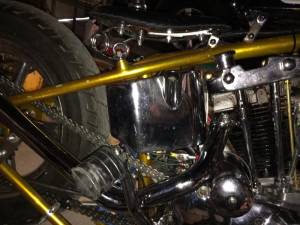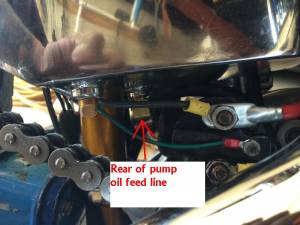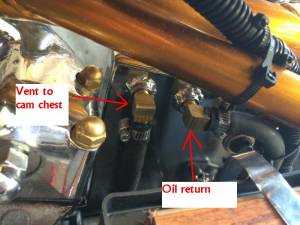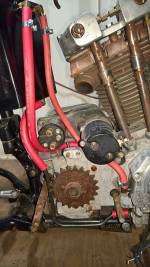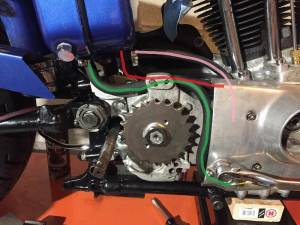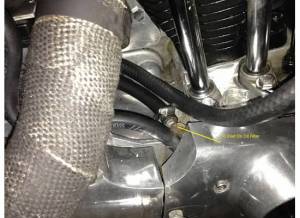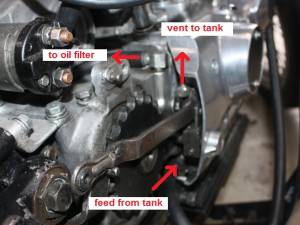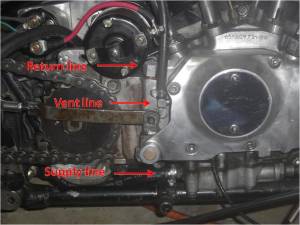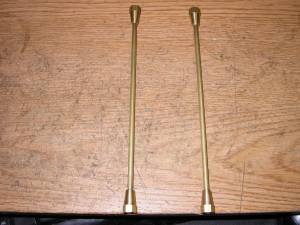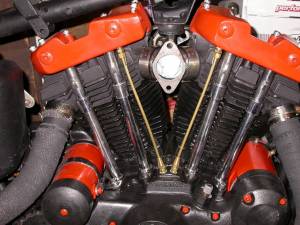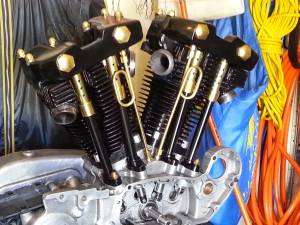Table of Contents
This is an old revision of the document!
IH: Oiling & Lubrication
Oil Tank, Lines and Routing
Sub Documents
Click on a pic to enlarge:
Oil Lines
The OD of the oil & vent lines is as important as the ID. 1)
If you buy automotive lines that are larger OD, they will be difficult to run in the limited space and easy to kink.
Oil lines for 59 and up:
Feed and Return: 3/8“ ID X 5/8” OD reinforced rubber.
Vent: 1/4“ ID, 1/2” OD reinforced rubber.
The tank is vented to the cam chest because, it applies a slightly negative pressure to the tank. 2)
This promotes the evacuation of condensate from the tank and keeps the tank from being pressurized.
(by the air that is also returned by the scavenge pump)
General oil line routing on AMF Sportsters:
The vent and the return lines route under the starter and solenoid. (can't run over them since the exhaust is there) 3)
Use care under the starter as to not kink or flatten the lines (rubber or copper) 4)
Feed line runs out the bottom of the oil tank, close to the chain, around the swing arm and under.
The filter and cooler are (plumbed) in the return line. 5)
Oil Line Routing
There is a steel bracket that holds the oil line in position. 6)
It mounts onto one of the rear engine mount or case bolts and keeps the line away from the chain.
The bracket is a piece of .060“ sheet metal about 3/4” wide and maybe 3“ long with a hole in one end where the bolt passes through it.
The other end is bent in a half circle that fits over the oil line and holds it against the frame / engine.
| Feed line behind the chain on 73 XLCH 7) | Missing clamp allows the chain to rub the hose. 8) | A steel line was used to replace the rubber hose. 9) |
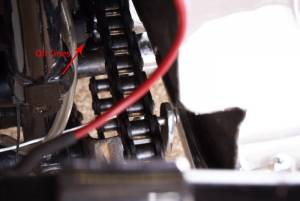 |  | 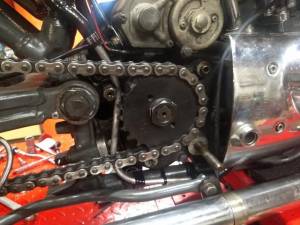 |
77-85:
The oil return comes off the front of the oil pump, not the top of the case like earlier years.
Essentially you have the following lines: 10)
Feed: From the bottom of the oil tank to the rear fitting (inlet) on the oil pump.
Return: From the top of the oil tank to the front oil pump fitting close to the pressure switch.
(perhaps after going through a cooler)
Vent: From the top of the oil tank to the 1/4” hose nipple on the upper backside of the cam cover in front of the sprocket.
| Oil Lines on 77 XLCH. 11) | |
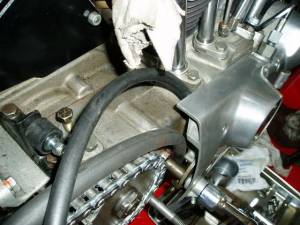 | 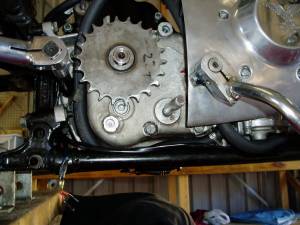 |
Connections at the Oil Tank
There are generally 4 holes on all early style oil tanks. 12)
Two near the bottom of the tank and two near the top.
The feed line will be near the bottom and the return line near the top.
These two lines will be bigger than the other two.
The smaller line at the bottom is the chain oiler (often not used and blocked off or just turned off).
The smaller line at the top is the vent for the tank.
(on early engines it runs to the top of the case just behind the rear cylinder)
There are internal drilling to route the vent into the cam chest (which vents to atmosphere).
On later engines it runs down to the cam cover which has a 90° fitting to accommodate it.
XLCH Oil Tank
In a horseshoe tank, the return oil should go to the far side so that oil has to migrate from one side of the tank to the other to get picked up again. 13)
Generic XLCH oil tank sketch 14)

Stock XLCH horseshoe tank: (L) 15), (R) 16)
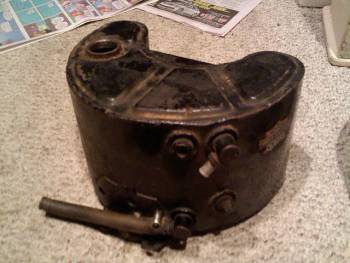
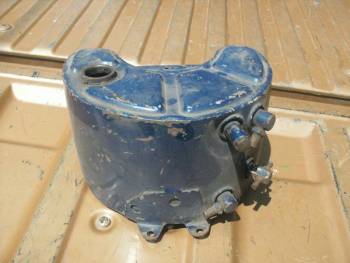
Aftermarket horseshoe tank (no drain): 17) 18)
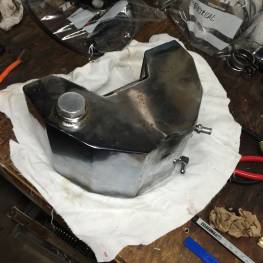

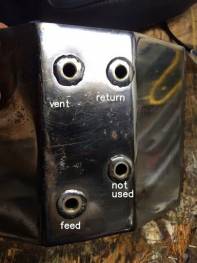
The stock lunch box tanks have the vent and return lines on the top of the tank (and feed on the bottom). 19)
Return (L), Vent (R)


XLH Oil Tank
Custom Oil Tank
This tank is pretty straight forward. 26)
Top (2) fittings are vent and fill.
Bottom fitting is supply to the engine.
It also has no drain fitting.
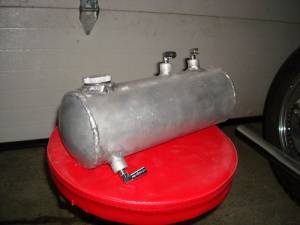
On this one (on a 74 XLH), the vent is higher than the feed and return lines. 27)
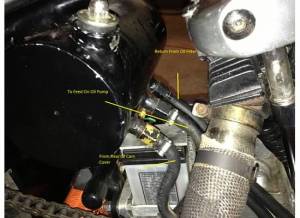
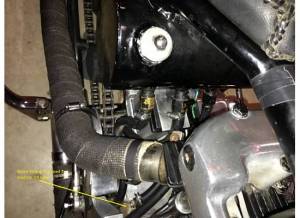
Connections at the Oil Filter
The oil filter (HD 63782-80T) is the small one that is usually used on custom bikes. Chrome or black can be found. 28)
It is also commonly known that the more oil you hold, the more motor heat can be transferred to dissipate that heat.
Race bikes have huge oil tanks for that reason. 29)
If you go the filter route, be sure to purge the lines by bleeding the pump front nipple first while running.
Then take the return line and place it into a pail before you connect to the barb tank fitting so you assure a complete circle has been made.
On all spin on oil filters, dirty oil goes in the outside of the filter. Clean oil comes out the center. 30)
If you are not sure, start the motor momentarily with the filter off and if oil is pumped out the center port, you have it backwards.
Plumbing for an external oil filter; 31)
Left or right side (depending on manufacturer) = Dirty oil in.
Center= Little bit cleaner oil out.
| Oil Line Routing 32) |
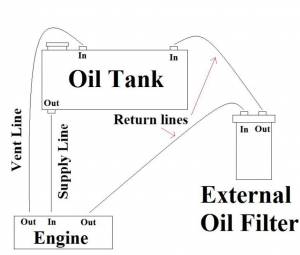 |
| 74 XLH Oil Filter Plumbing 33) |
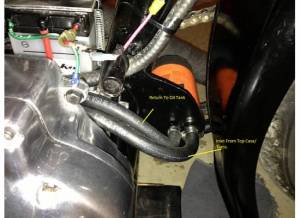 |
Connections at the Engine
Early Sportsters had the lines route to the top of the case. 34)
Later the MoCo routed a line directly to the back of the oil pump.
There is a transmission vent on top of the case in the area near the starter solenoid. 35)
This one should just vent to atmosphere, either up attached to the frame, or down aimed to ground.
| Oil line connections on a 61 XLCH 36) Fittings (L) Return, (R) Feed, (hole) Vent | Oil line connections on a 67 XLH 37) 1- Return to tank, 2- Feed to motor, 3- Vent hose 38) | Oil line connections on a 68 XLCH 39) |
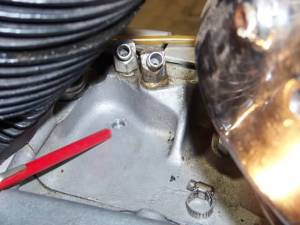 | 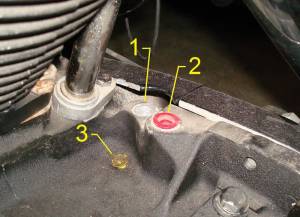 | 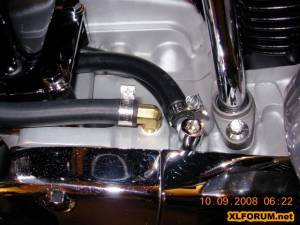 |
This pic of a 74 model shows the chain oiler fitting (circled in green) which is usually just plugged off. 45)
The one circled in red is the vent return to the tank.
| Oil fittings on a 74 model 46) |
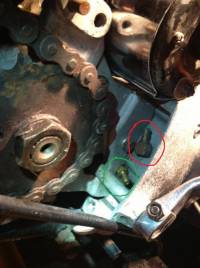 |
Connection to Oil Cooler
See External Oil Coolers in the REF section of the Sportsterpedia.
Oil Lines to the Rockers
Installation:
The ends are slightly different sizes. 47)
The larger-sized ends go on the case and the smaller-diameter ones go to the rockers.
In other words the closer they are to the oil pump, the bigger they should be.
Most people never even notice this.
Issues getting oil to the top end:
If your pump is primed, and the breather gear is properly timed, then the problem lies in the lines and/or their fittings.
If you have a leak here, you may not have to replace any parts.
Try to uninstall them, clean, inspect and reinstall them and see what happens.
Note for reinstalling the metal oil lines; 48)
The line is just long enough to be inserted a small amount at each end at the fittings.
So insert at the top, then the bottom ensuring that it is more or less even from top and bottom.
You can install the rubbers an inch or more from the line ends.
Then, while keeping it from shifting, slide the rubbers into place.
Then slip each line-end in place, and hold it there while sliding the rubbers into final position.
Tightening the nuts will seat the rubbers. Light grease on the rubbers will help.
Tighten them alternately, again keeping it from shifting.
Keep an eye on which style you buy (if any need replaced). 49)
The OEM is barrel shaped.
Some aftermarkets are a barrel with 45° cuts on the top and bottom.
The 45° ones are no good.
Either a different polymer is used or you really need that full barrel shape to seal the oil line properly.
| Rocker oil line 50) |
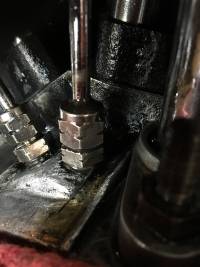 |
Braided Oil Lines
Braided lines can flex, leak, and sometimes flatten out. 51)
Before you try threading any threads into your engine, try threading them on a pipe fitting first. 52)
If the new parts are chromed then you should (must) wire wheel (with light pressure) the chromed threads before installation. 53)
This is especially important for chromed threaded bolts or bolts that have old Loctite on them.
* Always wear a face mask as you can loose hold of the bolt (using a wire wheel on a bench grinder) it will go flying.
You can lightly clamp the fastener flats in a vise and use a Dremil or angle grinder wire wheel also.
Either way, a mist of metal will get airborne and you don't need that getting into your eyes.
You can also chase the new threads with a die. This will also remove extra bulk on the threads due to the chroming process.
See also Chasing Threads in the REF section of the Sportsterpedia.
Copper, Brass and Stainless Tubing
These were made with flared fittings and are a positive seat fitting.
They do not allow for any growth once the motor gets hot (if that's a concern). 54)
The OEM style tubing uses slip compression type fittings which will allow expansion.
However, the flared fittings have been used on Sportsters.
Click on a pic to enlarge:
Copper
| Copper Oil Lines 55) |
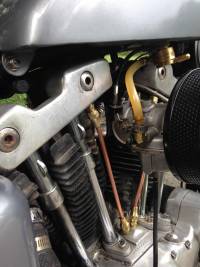 |
Brass
Stainless Steel
Stainless steel tubing will polish up like chrome and does not rust.
You can also use Parker stainless steel fittings and 1/4“ tubing. 58) 59)
They will come with compression fittings, DO NOT USE!!!!
On the bottom fitting.
On the upper fitting, drill the 1/4” hole to allow the tube to slide up into the rocker box.
There will still be a slight taper left.
This will allow you to insert the tube into the rocker box and then down into the bottom fitting stop.
You can cut pieces of fuel line hose to make the seal rings as it will resist the oil and heat.
You can use O-rings here if you have them also.
| Stainless steel oil lines 60) | |
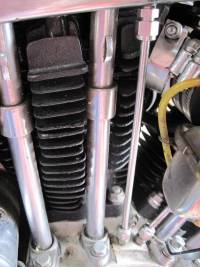 | 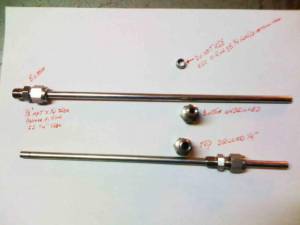 |




